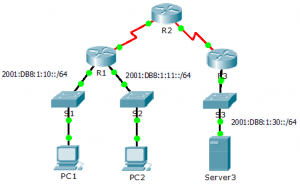Last Updated on November 8, 2018 by Admin
4.3.2.6 Packet Tracer – Configuring IPv6 ACLs
From year to year, Cisco has updated many versions with difference questions. The latest version is version 6.0 in 2018. What is your version? It depends on your instructor creating your class. We recommend you to go thought all version if you are not clear. While you take online test with netacad.com, You may get random questions from all version. Each version have 1 to 10 different questions or more. After you review all questions, You should practice with our online test system by go to "Online Test" link below.
Packet Tracer – Configuring IPv6 ACLs (Answer Version)
Answer Note: Red font color or gray highlights indicate text that appears in the Answer copy only.
Topology

4.3.2.6 Packet Tracer – Configuring IPv6 ACLs
Addressing Table
| Device | Interface | IPv6 Address/Prefix | Default Gateway |
| Server3 | NIC | 2001:DB8:1:30::30/64 | FE80::30 |
Objectives
Part 1: Configure, Apply, and Verify an IPv6 ACL
Part 2: Configure, Apply, and Verify a Second IPv6 ACL
Part 1: Configure, Apply, and Verify an IPv6 ACL
Logs indicate that a computer on the 2001:DB8:1:11::0/64 network is repeatedly refreshing their web page causing a Denial-of-Service (DoS) attack against Server3. Until the client can be identified and cleaned, you must block HTTP and HTTPS access to that network with an access list.
Step 1: Configure an ACL that will block HTTP and HTTPS access.
Configure an ACL named BLOCK_HTTP on R1 with the following statements.
a. Block HTTP and HTTPS traffic from reaching Server3.
R1(config)# deny tcp any host 2001:DB8:1:30::30 eq www
R1(config)# deny tcp any host 2001:DB8:1:30::30 eq 443
b. Allow all other IPv6 traffic to pass.
R1(config)# permit ipv6 any any
Step 2: Apply the ACL to the correct interface.
Apply the ACL on the interface closest the source of the traffic to be blocked.
R1(config)# interface GigabitEthernet0/1
R1(config-if)# ipv6 traffic-filter BLOCK_HTTP in
Step 3: Verify the ACL implementation.
Verify the ACL is operating as intended by conducting the following tests:
- Open the web browser of PC1 to http://2001:DB8:1:30::30 or https://2001:DB8:1:30::30. The website should appear.
- Open the web browser of PC2 to http://2001:DB8:1:30::30 or https://2001:DB8:1:30::30. The website should be blocked
- Ping from PC2 to 2001:DB8:1:30::30. The ping should be successful.
Part 2: Configure, Apply, and Verify a Second IPv6 ACL
The logs now indicate that your server is receiving pings from many different IPv6 addresses in a Distributed Denial of Service (DDoS) attack. You must filter ICMP ping requests to your server.
Step 1: Create an access list to block ICMP.
Configure an ACL named BLOCK_ICMP on R3 with the following statements:
a. Block all ICMP traffic from any hosts to any destination.
R3(config)# deny icmp any any
b. Allow all other IPv6 traffic to pass.
R3(config)# permit ipv6 any any
Step 2: Apply the ACL to the correct interface.
In this case, ICMP traffic can come from any source. To ensure that ICMP traffic is blocked regardless of its source or changes that occur to the network topology, apply the ACL closest to the destination.
R3(config)# interface GigabitEthernet0/0
R3(config-if)# ipv6 traffic-filter BLOCK_ICMP out
Step 3: Verify that the proper access list functions.
- Ping from PC2 to 2001:DB8:1:30::30. The ping should fail.
- Ping from PC1 to 2001:DB8:1:30::30. The ping should fail.
Open the web browser of PC1 to http://2001:DB8:1:30::30 or https://2001:DB8:1:30::30. The website should display.
From year to year, Cisco has updated many versions with difference questions. The latest version is version 6.0 in 2018. What is your version? It depends on your instructor creating your class. We recommend you to go thought all version if you are not clear. While you take online test with netacad.com, You may get random questions from all version. Each version have 1 to 10 different questions or more. After you review all questions, You should practice with our online test system by go to "Online Test" link below.
